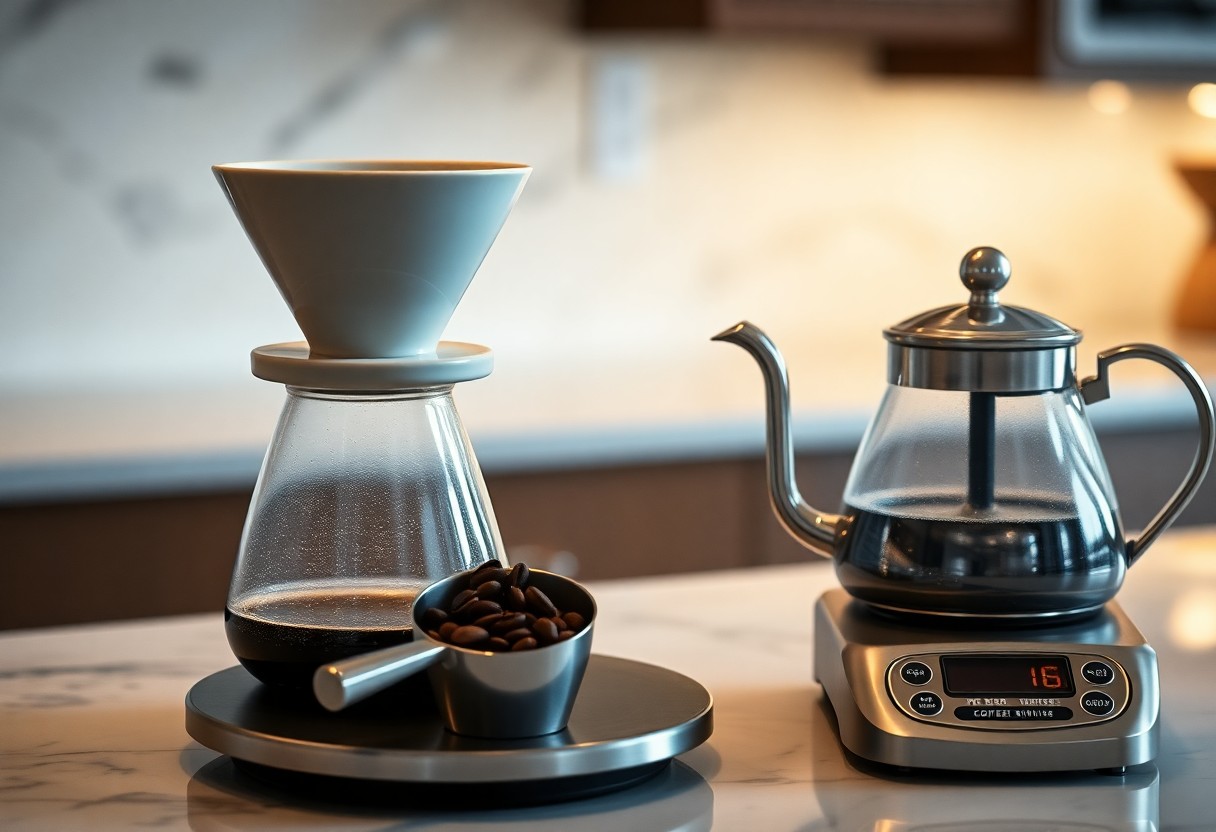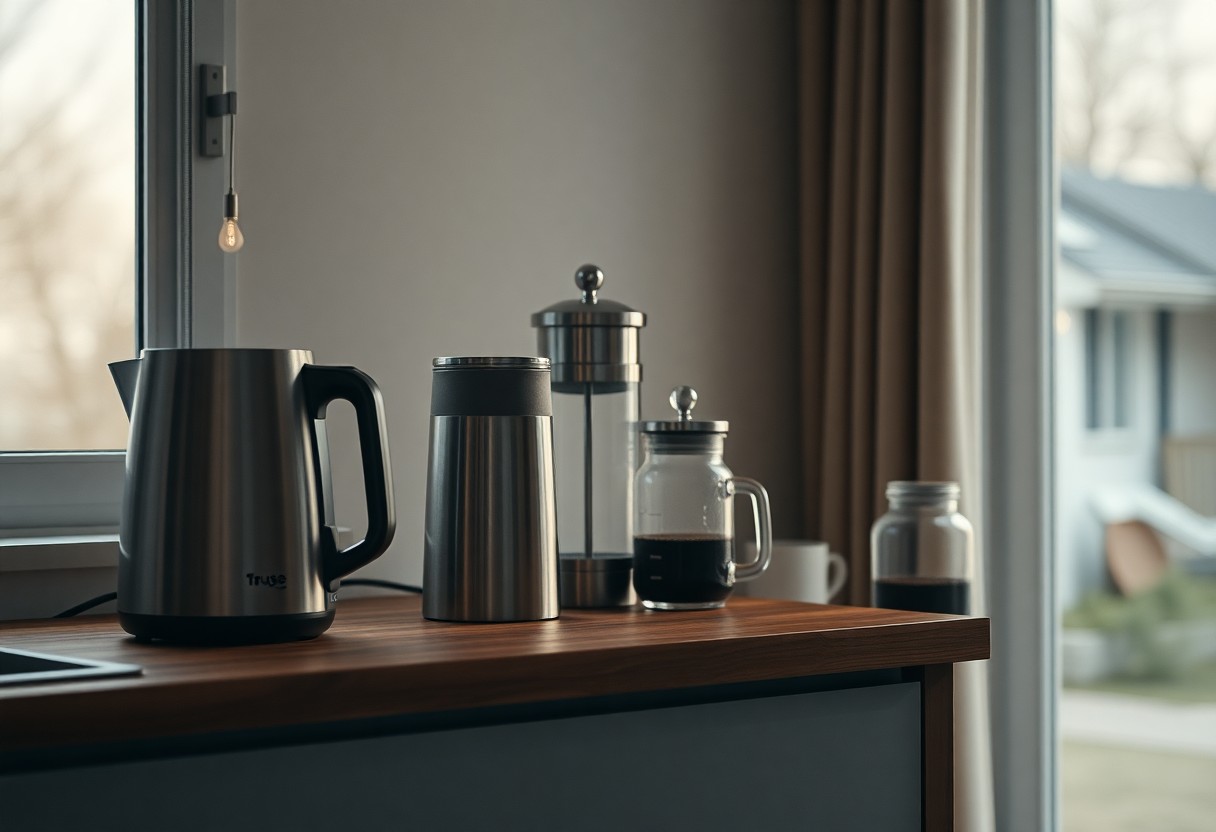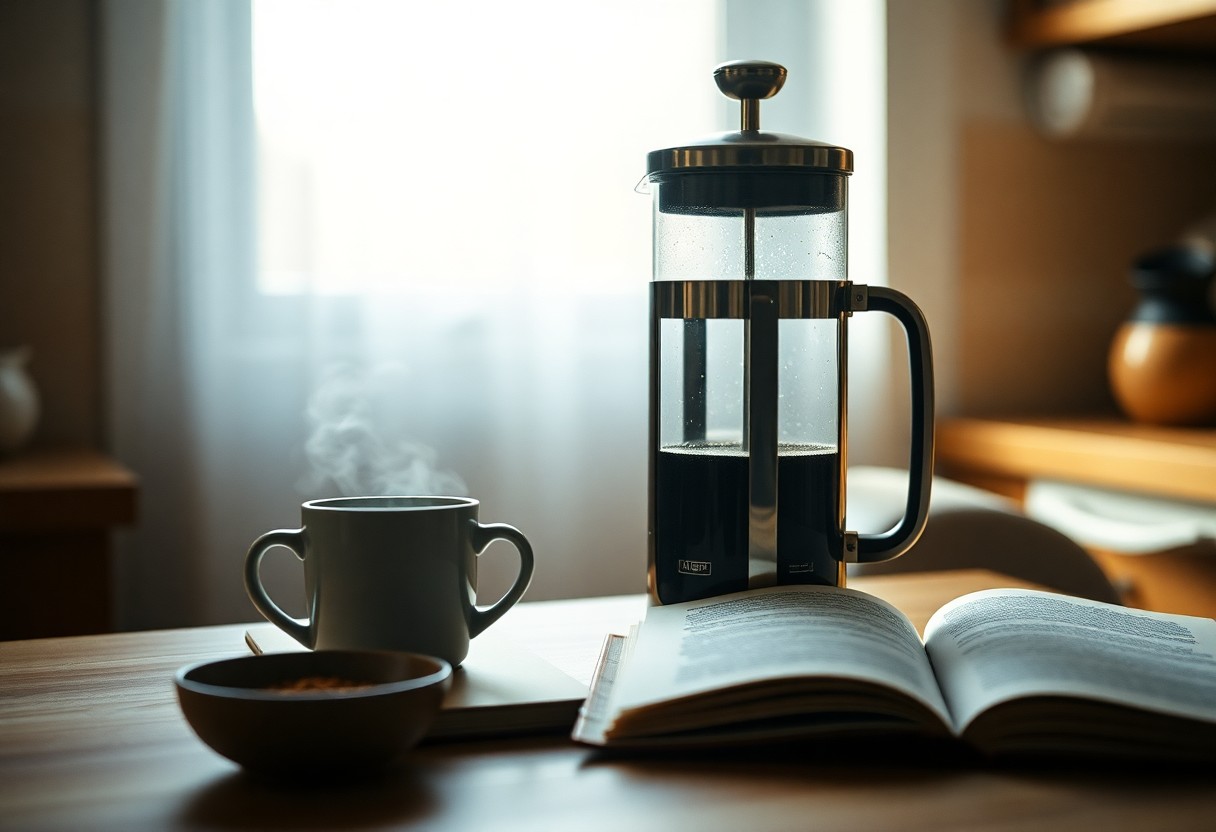Many coffee lovers struggle with the challenge of brewing their favorite morning drink while ensuring they don’t disturb anyone still asleep in the house. By employing quiet brewing methods, you can enjoy a delicious cup of coffee without the loud noises typically associated with traditional brewing techniques. This post will guide you through several effective approaches that allow you to savor your coffee ritual early in the morning without causing any disturbances. With these practical tips, you’ll be able to maintain the peace and tranquility of your home while still indulging in that beloved morning brew.
Key Takeaways:
- Explore various quiet brewing methods such as cold brew, French press, or using manual pour-over techniques to minimize noise during preparation.
- Invest in specialized equipment like a low-noise grinder or a non-electric brewing system to create a peaceful coffee-making environment.
- Time your brewing process strategically, considering the optimal time for coffee preparation while maintaining a low sound profile.
The Art of Quiet Brewing Methods
Finding the right brewing method that minimizes noise without compromising on flavor requires a bit of finesse. Each technique possesses its distinct charm and effectiveness, allowing you to enjoy your coffee rituals peacefully, even during the early morning hours. By exploring different brewing methods and appliances, you can orchestrate a brewing experience that delights your senses while keeping noise levels to a whisper.
Silent Brewing Appliances: The Best Options
Investing in silent brewing appliances can significantly reduce morning noise. Look for machines that feature quiet operation modes, such as the Breville BDC450 Precision Brewer or the Moccamaster KBG, known for their efficient brewing systems with minimal sound. Additionally, some espresso machines, like the Nuova Simonelli Oscar II, are designed to operate quietly, ensuring you get that espresso fix without waking the rest of the household.
Manual Techniques for Minimal Noise
Embracing manual brewing techniques is another excellent way to brew quietly. Methods such as the pour-over or French press allow you to control the brewing process while minimizing extraneous noise. With a gentle pour and slow press, you can enjoy the ritual of making coffee without any harsh mechanical sounds, creating a serene environment perfect for early mornings.
Utilizing manual brewing techniques involves simple actions that are inherently quieter than automated machines. For example, consider using a Chemex or Hario V60 for pour-over coffee; both require precisely timed water pouring and can be performed efficiently with a gooseneck kettle. These methods allow you to adjust water flow to avoid splashing, thus reducing sound. Additionally, when using a French press, opt to slowly plunge the filter down rather than pushing it forcefully, which emits minimal noise. The tactile nature of these processes often enhances your overall coffee experience, giving you a greater appreciation for each step while keeping a peaceful atmosphere at home.

Choosing the Right Coffee Beans
Selecting your coffee beans directly impacts the brewing experience and final taste. Focus on beans that suit your flavor profile and the quiet brewing methods you plan to use. Exploring different types such as single-origin or blends can lead to delightful discoveries. Opting for low-acidity varieties can also enhance the flavor and reduce potential bitterness, making for a more enjoyable morning ritual without disturbing anyone in your household.
Low-Acidity Beans for Enhanced Flavor and Calm
Low-acidity beans are excellent choices for smooth, rich flavors without the sharp tang found in higher-acidity options. Beans like Sumatran or Brazilian are well-known for their mellow profiles. These selections help offer a more balanced cup that allows you to savor the quiet moments of your brewing routine, free from the jarring notes commonly associated with high-acidity coffee.
Whole Bean vs. Pre-Ground: Noise Considerations
Choosing between whole bean and pre-ground coffee can significantly affect your morning routine’s noise levels. Grinding beans produces noise, particularly if you’re using a blade grinder. For quieter mornings, opt for a burr grinder, which tends to operate more quietly than its blade counterpart. Additionally, grinding beans ahead of time, while less fresh, can help minimize morning disturbances.
Trade-offs between whole bean and pre-ground options often involve taste and convenience. Whole beans, while requiring grinding, offer fresher flavors and often come with less packaging noise when opening. In contrast, pre-ground coffee can be a lifesaver for quick, noiseless morning cups. If you prefer to grind your beans for freshness, consider grinding them the night before and storing them in an airtight container. This way, you can enjoy both quiet mornings and the rich aromas of freshly sourced coffee without waking up the household.
Timing Matters: Brewing at Optimal Hours
Choosing the right time to brew coffee can significantly enhance your experience while minimizing disruptions at home. Early mornings, particularly before the household starts its daily activities, are ideal for brewing quietly. Aiming for a window of 5-7 AM ensures you can savor your cup before others wake. Additionally, brewing during non-peak hours, such as mid-afternoon, can provide a refreshing pick-me-up without interfering with evening routines.
How to Brew Coffee Early Without Disturbing Others
Brewing coffee early involves utilizing equipment designed for efficiency and quiet operation. Opt for silent grinders that minimize noise, or choose a drip coffee maker with a programmable feature that allows you to set the brew time while you sleep. Using a French press or pour-over method can also help, as these methods require less machinery and produce little sound compared to electric brewers.
The Benefits of Pre-Preparing Ingredients
Pre-preparing your coffee ingredients not only saves precious minutes in the morning but also contributes to quieter brewing sessions. By measuring coffee grounds and filling your water reservoir the night before, you eliminate the need for noisy equipment and extensive movements early in the day.
By pre-preparing your coffee ingredients, you streamline your morning routine, allowing you to focus on enjoying your brew rather than rushing through the process. This advance prep can include grinding beans, measuring grounds, and having all necessary equipment within arm’s reach to minimize noise and motion. Consequently, this preparation not only aids in a more peaceful morning but can also enhance your coffee’s freshness and flavor, as you maintain better control over each brewing variable. By investing these few extra moments the night prior, your morning ritual transforms into a more tranquil and enjoyable experience.
Sound-Absorbing Mugs and Accessories
Selecting sound-absorbing mugs and accessories can transform your coffee experience. These innovative designs minimize noise during your morning ritual, allowing you to enjoy your brew without disturbing anyone in the house. Look for specialized products that feature silicone lids or insulated double-walled structures, which reduce sound made by clinking or slurping. With these options, the act of sipping your coffee becomes a tranquil part of your morning instead of a disruptive affair.
Innovative Designs for Quiet Coffee Consumption
Many brands now focus on creating mugs that incorporate sound-dampening technology. These designs may include features like integral lids to eliminate splashes or specially designed noses that minimize sipping noise. By prioritizing quietness, these mugs help you savor your favorite blend without creating unnecessary disturbances. It’s a blend of function and form, enabling you to delight in your coffee ritual with peace.
The Role of Materials in Noise Reduction
The materials used in sound-absorbing mugs play a significant role in their effectiveness. High-density ceramics, silicone, and specific thermal insulation techniques all contribute to muffling sound during coffee preparation and consumption. For instance, ceramic is known for its excellent ability to dampen vibrations, while silicone serves to cushion impacts. These materials not only enhance durability but also promote a quieter experience as you enjoy your morning brew.
When considering materials, realize that the thickness and density can significantly affect noise levels. For example, a thicker ceramic mug may reduce sound better than a thin plastic one, due to its mass which absorbs and dissipates vibrations. Additionally, double-walled designs utilize air pockets to create insulation, further quieting the sounds of liquid movement. Brands like “QuietCup” have capitalized on these findings, showcasing how a simple change in materials can enhance your coffee enjoyment while preserving a serene environment. Investing in such designs is a small step toward a quieter morning routine.

The Psychological Impact of Quiet Coffee Rituals
Your morning coffee ritual has profound psychological benefits that extend beyond mere caffeine intake. Engaging in a quiet brewing process allows you to cultivate a sense of peace and harmony that can powerfully influence your day. By making an intentional effort to minimize noise, you set a tone of mindfulness, fostering a deeper connection to the present moment. This approach not only promotes relaxation but also encourages positive mental states, creating a sanctuary that prepares you to face daily challenges with greater resilience.
Promoting Mindfulness in Your Brewing Process
Mindfulness during coffee preparation allows you to engage fully with the experience, turning routine into ritual. By concentrating on each step—whether measuring, grinding, or pouring—you cultivate awareness that enhances your senses. The soothing aromas and gentle motions of this process invite focused attention, effectively grounding you in the now and releasing stress from the night before.
Establishing a Tranquil Morning Routine
Creating a tranquil morning routine enhances your coffee experience and sets a calm tone for the rest of your day. By rising early and allowing yourself to engage in quiet activities such as stretching or journaling, you create a serene ambiance. Coupling this with your silent coffee ritual transforms routine into a rewarding personal sanctuary, allowing you to savor each sip amidst tranquility. The absence of rushing gives you space to reflect, plan, and mentally prepare for the hours ahead, which can enhance overall productivity and emotional well-being.
Final Words
Drawing together the various methods for making coffee without waking the house, you can embrace a quieter routine that respects the slumber of others. Whether you opt for a French press, cold brew, or a quiet drip coffee maker, each technique allows you to savor your morning brew without the disturbance of loud machinery. By implementing these strategies, you ensure your coffee rituals remain a personal joy while keeping your household undisturbed. Enjoy the peace of brewing your perfect cup when the rest of the world is still sleeping.
FAQ
Q: What are some quiet brewing methods for making coffee?
A: Several methods of brewing coffee can minimize noise, including using a French press, pour-over coffee makers, cold brew systems, and single-serve manual brewers. Each of these methods allows for a quieter brewing experience, helping to keep noise levels down as you prepare your morning cup.
Q: How does a French press work quietly?
A: The French press operates through a simple immersion process. You coarsely grind your coffee beans, add them to the press with hot water, allow them to steep, and then slowly press down the plunger. This method produces minimal noise compared to electric coffee makers, as it doesn’t require vigorous brewing mechanisms or loud motors.
Q: What is cold brew, and is it quiet to make?
A: Cold brew coffee is made by steeping coarsely ground coffee beans in cold water for an extended period, typically 12-24 hours. This method is very quiet since it does not involve boiling water or any brewing equipment that generates noise. It’s perfect for preparing coffee ahead of time, allowing you to enjoy a smooth, ready-made drink without any morning interruptions.
Q: Can I use a manual pour-over coffee maker without much noise?
A: Yes, manual pour-over coffee makers like the Chemex or Hario V60 are excellent for silent brewing. You can control the pouring of hot water over the coffee grounds at your own pace, producing very little sound. This method also allows for a focused brewing experience, making it enjoyable without disturbing others.
Q: Are there any tips for grinding coffee beans quietly?
A: To grind coffee beans quietly, consider using a hand grinder instead of an electric grinder, as they are typically much quieter. Pre-measuring the beans and choosing coarser settings can also reduce noise, as finer grinds require more effort and time. Additionally, using a towel to cushion the grinder while in use can further dampen sounds.
